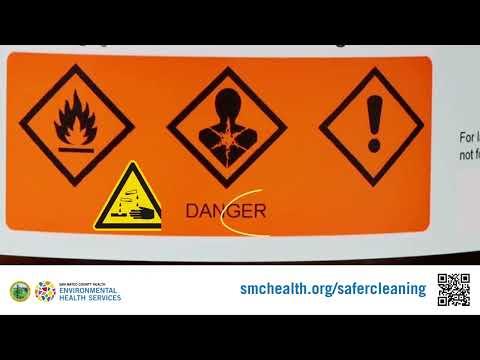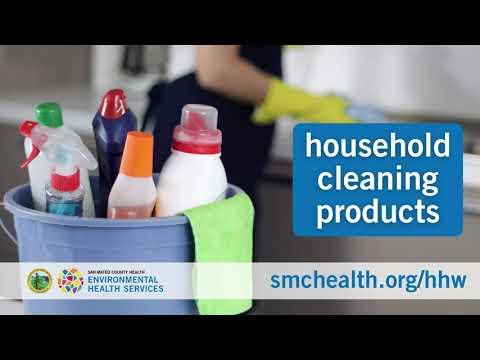Safer Cleaning At Home
Protect your family from harsh chemicals by making your own household cleaning products using these simple ingredients:
- Lemon juice
- Liquid soap free of antibacterial, Triclosan, and fragrance
- Baking soda
- Vinegar (diluted)
- Hydrogen peroxide (3% solution)
- Microfiber cloth
- Scrub brush
Safer cleaning techniques also work for preventing pests and cleaning mold.
Do the products I use contain hazardous chemicals? Read the label! See Healthy at Home: Reduce your Exposure to Hazardous Products in our Pollution Prevention blog.
Video Los Básicos de la Limpieza Menos Tóxica.
Air Freshener:
- Leave open boxes of baking soda in the refrigerator, closet or bathroom.
- Sprinkle baking soda in the bottom of trash cans.
- Simmer water with cinnamon sticks, orange peel, or cloves.
- Insert cloves into a fresh orange.
- Keep all rooms and closets clean and well-ventilated. Use ventilation fans.
All Purpose Cleaner
- Mix (Triclosan free) liquid soap with water.
- Mix liquid soap with 1 tablespoon of baking soda, lemon juice, and water.
- Fill a spray bottle with 1 part vinegar, 1 part water, and add some lemon juice to create a fresh and natural scent.
Drain Opener
- Pour 1/2 cup of baking soda into the drain, followed by 1/2 a cup of vinegar. Wait 15 minutes, then pour 2 quarts of boiling water down the drain.
- Drain opener is one of the most toxic consumer products sold.
Carpet Deodorizers
Sprinkle 2 cups baking soda on the carpet (option to add up to 30 drops lavender or other essential oil). Let it set overnight, or for as long as possible. Vacuum.
Carpet, Rug, and Upholstery Cleaner
Mix 1 quart warm water, 1 tablespoon of mild liquid soap, 2 tablespoons baking soda, and add a squeeze of lemon or a splash of vinegar. Apply a damp cloth or sponge and rub gently. Wipe with a clean cloth and allow to dry thoroughly or mold may grow.
Glass, Windows, and Mirrors
Mix 1 quart water, 1/2 cup of white vinegar, and 2 tablespoons of lemon juice in a spray bottle. Shake to blend. Spray surfaces and rub with a clean, soft, lint free cloth or newspaper.
Hand Soap
Use plain soap, free of fragrance, antibacterial chemical, dye, and color.
Kitchen: Countertop, Floor, & Appliances
- Use soapy water or soapy water mixed with vinegar.
- Combine 1 part vinegar with 1 part water into a spray bottle.
Mold and Mildew
- Go to smchealth.org/healthyhome for moisture and mold reduction tips.
- Mix 2 tablespoons of tea tree oil into 2 cups of water and apply with a sponge. Dry thoroughly.
- Reduce moisture. If a surface is damp, mold can grow. Spores circulate in the air and cannot be eliminated.
- Let white vinegar sit on the mold. Clean with soapy water. Dry thoroughly or mold may return.
- To clean mildew from a shower curtain, machine wash with a 1/2 cup of soap and a 1/2 cup of baking soda, then add 1 cup of white vinegar to the rinse cycle.
Oven
Mix 2 tablespoons of liquid soap, 2 tablespoons of baking soda, 1 tablespoon of salt, and add warm water to desired consistency. Apply to oven and leave on for 20 minutes, then scrub.
Tile/Grout
Combine 1 cup of baking soda with 1/2 cup of hydrogen peroxide. Add 1 teaspoon of liquid soap and mix. Using a squeeze-top bottle, let sit on grout for 5 minutes or scrub immediately. Rinse well with water.
Toilet Bowl
- Pour 1/4 cup of baking soda into the toilet bowl and sprinkle with vinegar or hydrogen peroxide (3% solution), then brush.
- Hydrogen peroxide (3% solution) can also be used like a disinfectant.
Wood Furniture & Floor Polish
- Mix 2 parts vegetable oil to 1 part lemon juice. Rub mixture in and let sit for 5 minutes. Polish with a soft cloth.
- Oil soap is also an effective, safe option.
Laundry Detergent
- Use mild, biodegradable detergents. Look for naturally derived or glycerin-based soaps.
- In a gallon jug, mix 7 cups of hot water, ½ cup baking soda, and 1/4 cup salt. Repeat this step with another 7 cups of hot water, ½ cup baking soda, and 1/4 cup salt. Then add 1 cup of liquid castile soap. Option to add up to 30 drops of lavender or other essential oil.
- Avoid dryer sheets. The strong, artificial fragrances contain synthetic chemicals such as phthalates.
Already made the switch to safer cleaning products? Make an appointment to safely dispose of your old cleaning products at smchealth.org/hhw-appt or smchealth.org/hhw-appt-espanol


